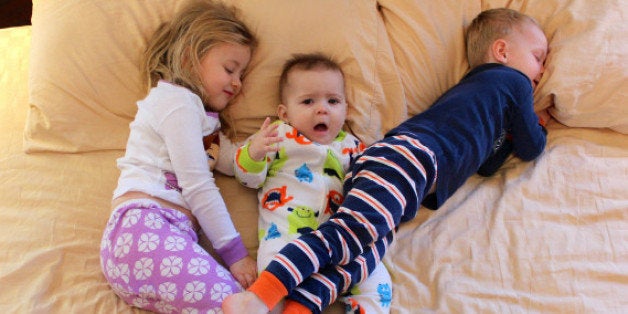
The "A" position: When a toddler climbs into bed with their parents and wedges them apart at their hips.
The "B" position: When a parent tries to put a pillow between themself and two kids, but both kids still manage to curve around their respective pillows far enough for their itchy hair and cold toes to bother the parent all night.
The "C" position: When a parent curves their body around a pool of urine in the middle of the bed.
The "D" position: When one parent has been pushed to the very edge of the bed while the other parent's butt has already been knocked to the floor and only their outstretched fingers and toes remain atop the bed.
The "E" position: When two parents each lay an arm across the top of the bed so their toddler can rest their head on both parents' arms at the same time.
The "F" position: When a parent lies in bed and two toddlers position themselves perpendicular to the parent, one lying their head on the parent's face and the other on the parent's stomach.
The "G" position: When a parent curls into a fetal position because they can't get five consecutive minutes of sleep.
The "H" position: When a toddler rests their head on one parent's belly and their feet on the other parent's belly. (Typically, the toddler changes their direction many times throughout a night.)
The "I" position: When a parent lies still with their hands at their sides in fear of waking their toddler -- who is sleeping directly atop the parent.
The "J" position: When a parent lies still with their hands at their sides in fear of waking their toddler -- whose feet are pushing the parent's head to the side.
The "K" position: When two parents form a right angle against the headboard because they have given up trying to stop kids from crawling into the middle of their bed at night.
The "L" position: When a parent lies in bed with one outstretched arm trapped under their toddler's head. (Typically, the parent's arm is the only part of the parent to fall asleep due to the toddler's snoring, coughing and pleas for the parent to get up.)
The "M" position: When two toddlers share a pillow with the parent closest to them, but still find reason to kick each other under the covers all night.
The "N" position: When a toddler lies diagonally in bed between parents to take up the most amount of space possible.
The "O" position: When a parent withdraws into a cannonball position to defend themself against a toddler who won't stop jumping on the parent's head.
The "P" position: Not a physical position as much as it is a state of mind. Throughout a night, a parent must remain in an alert P position to be able to quickly dodge or clean pee before a hazardous situation devolves any further.
The "Q" position: When a parent tries to cover their whole body with the sheets but their toddler claims such a disproportional amount of sheets that the parent's leg sticks out at the bottom.
The "R" position: When one parent is hiding between the headboard and the mattress while the other parent is in the cannonball position (also known as Position O) getting kicked in the kidneys by a toddler having a night terror.
The "S" position: The shape of a parent's spine after countless nights contorting their body around a toddler.
The "T" position: When a parent stretches their arms out to the sides to allow up to four children (or one child and up to three stuffed animals) to rest their head on each arm.
The "U" position: When two parents and a toddler are all sleeping on an edge of the bed because everybody is too tired to care about the risks of falling out anymore.
The "V" position: When two parents have to share a pillow because their toddler has taken the other pillows (and the sheets) and is hiding them somewhere in the house.
The "W" position: When four children conspire to take up every inch of space in their parents' bed, forcing the parents to spend the night in separate toddler-size beds and reflect on whether they were as prepared as they thought they were to have the fourth baby. (This position is also known as the coup d'état.)
The "X" position: When a toddler lies across their parent's belly to leverage their weight and keep the parent pinned down.
The "Y" position: When a parent stretches both arms high above their head and yawns, knowing that they won't be getting any real rest.
The "Z" position: Ironically named because no parent will ever get zzzzz's again if their toddler becomes a fully-grown adult who still sleeps diagonally because their parents never made them learn how to sleep in their own bed.